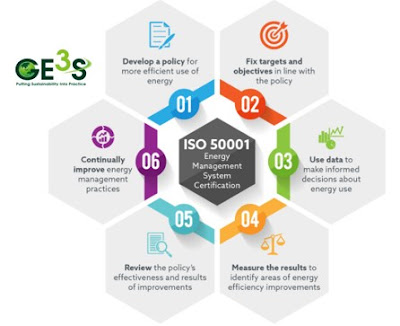Energy Audit and Carbon Footprint Go Hand In Hand to Combat Climate Change.
Energy audit is a way if checking the energy is used and
identify areas where wastage can be minimized if not totally eradicated.
Reduced energy consumption leads to reduction in GHG emission and therefore
limits our carbon footprint. Energy audit consists of tasks that can be carried
out depending on the type of audit and the function of audited facility. It
starts with review the historical data of energy consumption taken from the
electricity bills. The energy data is important in order to understand the
patterns of energy used and their trend. Once obtaining the information on
energy consumption, the next step is to set up an energy audit program. GE3S is
a well-known energy auditor in Dubai and has conducted several energy audits in
the region. We also conducted carbon footprint for several companies.
As an energy auditor in Dubai, we have conducted several
energy audits in industries and buildings. GE3S Energy auditor conducted energy
audit as part of LEED EBOM platinum certification for an Office Building in
UAE. We are also successful in reducing its carbon
footprint.
The energy audit was performed to comply with the
requirements of pre-requisite 1: Energy Efficient Best Management Practices
& EAc2.1: Existing Building Commissioning - Investigation and Analysis. The
detailed energy audit was conducted for the Office Building located in Dubai.
The objective of this project is to conduct integrated energy
& water audit for regional Office in Dubai, UAE so that the carbon
footprint of the building goes down. The purpose of this Audit is to
investigate and identify all possible opportunities to improve the efficiency
of energy & water consuming systems and in-turn reduce their consumption,
improve the building performance, and eventually distinguish the building as
energy efficient and Green building. GE3S is team of certified from Certified
Energy Auditors and USA Professional Engineer (P.E.) License holders in Dubai.
GE3S conducted site visit throughout the building focusing mainly on the major
energy consumers that are HVAC systems, lighting & pumps.
The audit covered the areas related to occupants comfort,
health, and systems that have an effect on the building’s energy consumption.
This includes HVAC system, Electrical distribution system, Lighting and
Building Envelope. GE3S Energy Auditors identified opportunities to reduce the
energy use and carbon footprint of the office building. Some of the energy
conservation measures identified by GE3S Energy Auditors is to Optimize
Operation of the Recovery Wheel on the FAHUs, Lighting Replacement with LED
Lights and Installation of Motion Sensors. If the reduced energy consumption us
supplemented by renewable energy then the building can also become carbon neutral.
The heat recovery wheels in the building automatically turn
on when the FAHUs turn on. This is a very good practice during the hot season,
but when the outside air is cooler than the set point for the inside air, the
heat recovery wheel will not be warming outside the outside air and resulting
in an unnecessary cooling load. It is suggested that the heat recovery wheel be
used
only when the outside air is two dregs warmer than the
exhaust air. This resulted in the annual energy savings of 1,024 kWh/yr. and move
the client towards the climate neutral target.
During the energy audit, GE3S found that a lot of inefficient
lighting is installed in the building. There are numerous halogens, CFL, metal
halides, and other bulbs replaced with Light Emitting Diodes (LED) lights. LED
lighting has the following benefits Longer Life, More Energy Efficient,
Ecologically Friendly (free of toxic chemicals) and instant Lighting &
Frequent Switching. This resulted in the
annual energy savings of 314,008 kWh/yr. As a leading Energy Auditor, GE3S have
helped several clients in reducing Energy Costs. Energy audit and carbon
footprint are steps taken towards a carbon neutral future.




Comments
Post a Comment